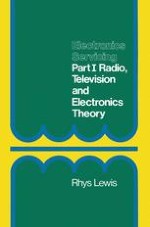1981 | OriginalPaper | Chapter
Electrical resistance
Author : Rhys Lewis, B.Sc.Tech., C.Eng., M.I.E.E.
Published in: Electronics Servicing
Publisher: Macmillan Education UK
Included in: Professional Book Archive
Activate our intelligent search to find suitable subject content or patents.
Select sections of text to find matching patents with Artificial Intelligence. powered by
Select sections of text to find additional relevant content using AI-assisted search. powered by
If the same voltage is applied across pieces of different materials such as copper, iron, Nichrome (a mixture of nickel and chromium) and glass, which are of equal size and at the same temperature, the amounts of electric current which flow in each piece are different. The largest current flows in the copper, less current flows in the iron, less still in the Nichrome and the current in the glass will be so small as to be virtually undetectable. The reason for this is the different atomic structure of the materials. Copper atoms have outer electrons which are so loosely bound to their ‘parent’ atoms that only a small amount of energy per electron is required to free it. Glass, on the other hand, has atoms which contain tightly bound electrons and a great deal of energy per electron is required before electrons can move away and form an electric current. The other materials require varying amounts of energy per electron, Nichrome needing about ten times as much as iron. The same voltage (which is a measure of energy per unit charge and therefore energy per electron) will thus cause more current in the copper than in the iron, even less in Nichrome and least of all in glass. Copper and other similar materials such as silver, gold and aluminium are said to be good conductors glass and materials such as rubber and plastics are good insulators. Materials between these two extremes may be called conductors or insulators depending on their electrical properties and there is a special class of materials called semiconductors which, strictly speaking, are neither conductors nor insulators.
